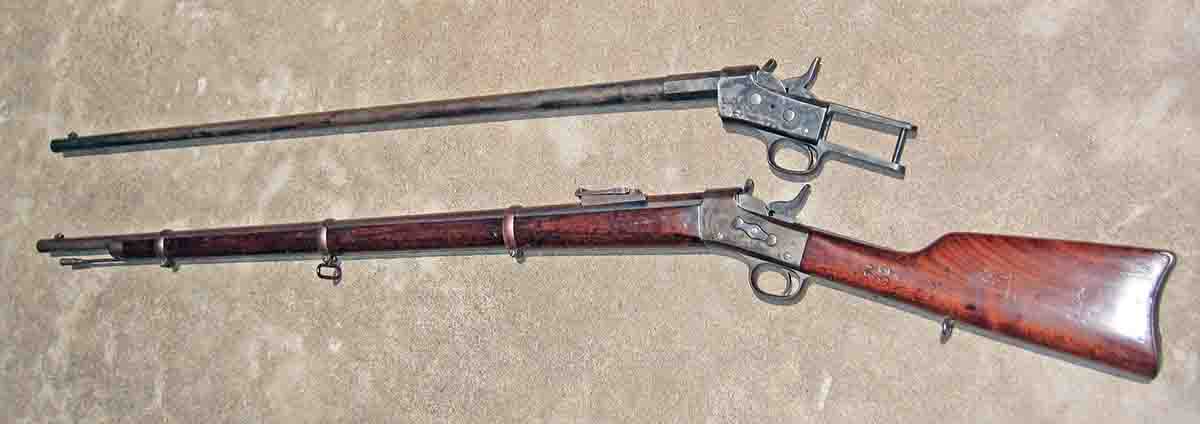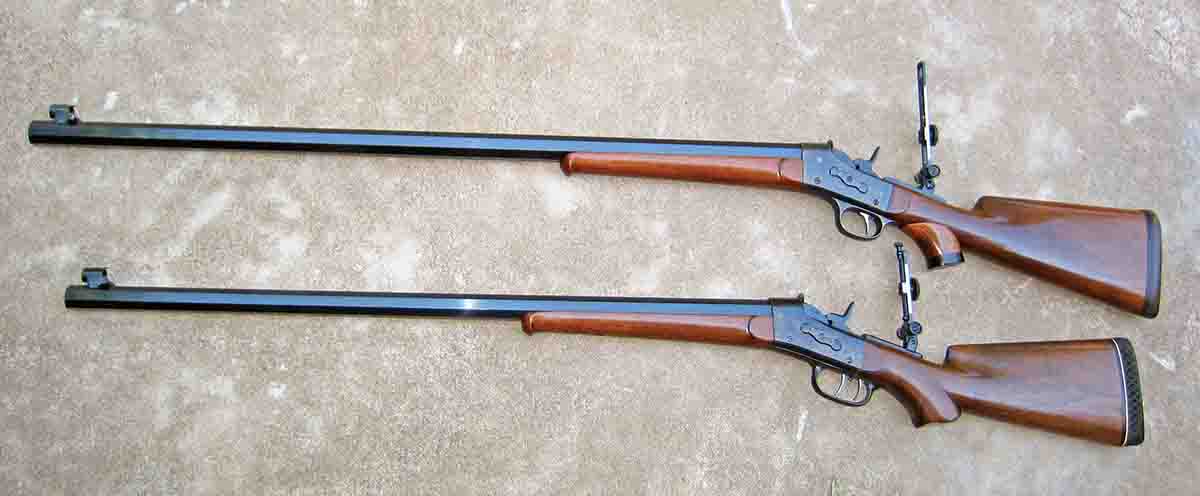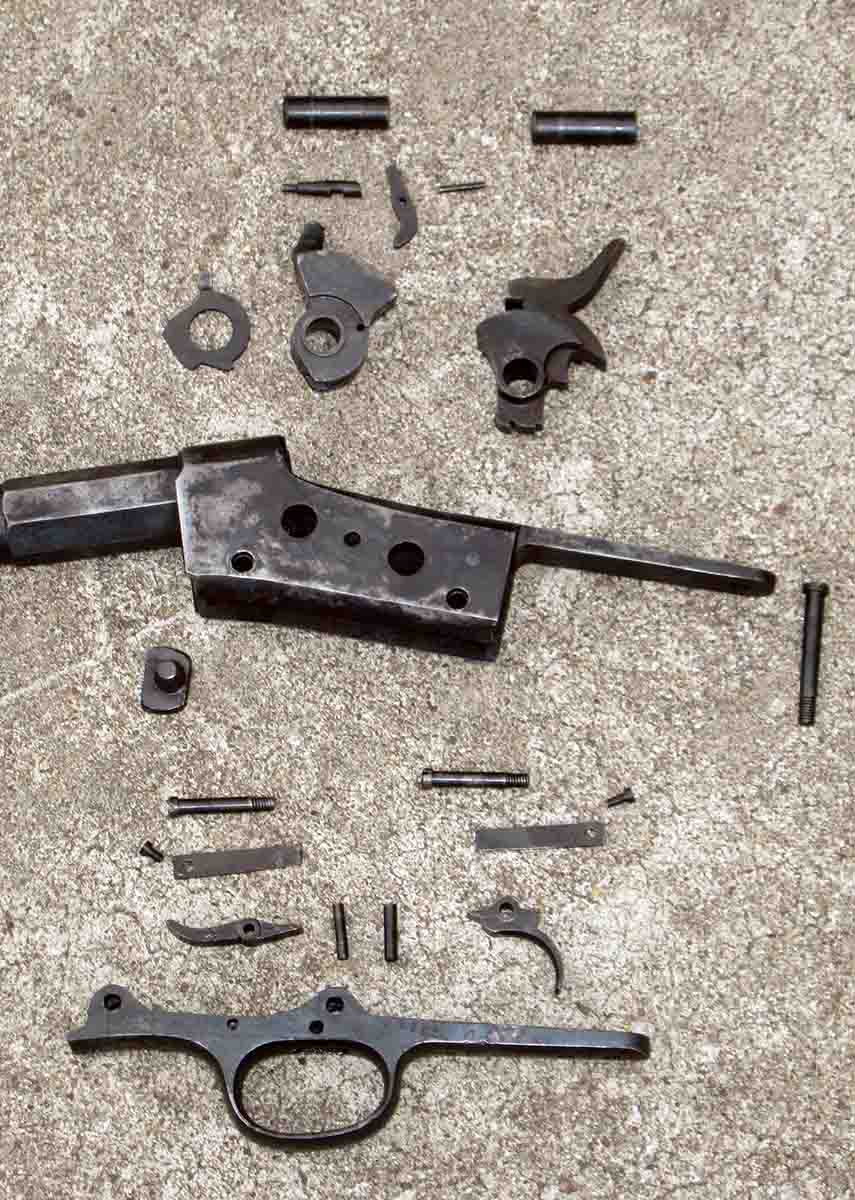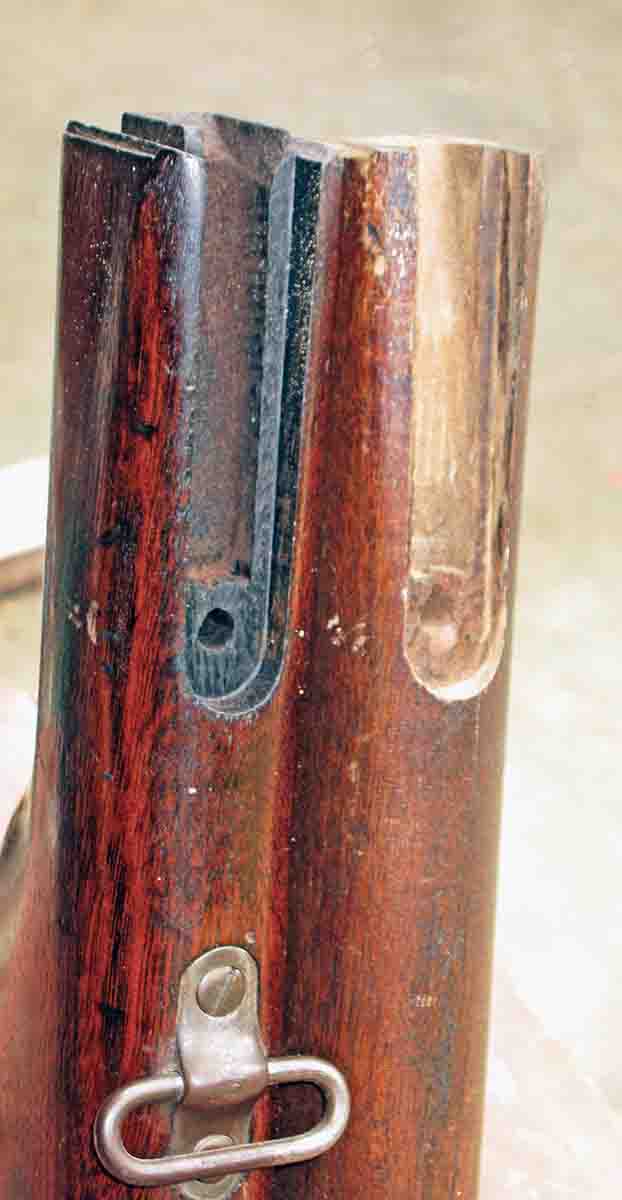
A relic barreled action shown with complete Modelo 1879.
I well remember the first Remington Rolling Blocks I acquired. I had just completed two years of active duty in the army and wanted to increase my fledgling military rifle collection that was limited to a K98k, a Japanese 6.5mm carbine and a captured SKS. In the spring of 1970 at Deep River Armory, Inc. in Houston, Texas, I pulled a trio of ancient, three-band Rolling Blocks from a tall, wooden barrel. The actions were rusted shut and the wood was present but ugly. The price was $12.50 each, and I figured I could probably make one rifle from the three. With the help of a few parts from Dixie Gun Works and lots of elbow grease, all three of the .43 Spanish rifles were returned to shooting condition. It was at this point I began to understand why most Rolling Blocks, including very rough ones, are salvageable.

.50-70 (above) and .38-55 match rifles based on military actions.
In the years since finding the Remingtons in the barrel, all of the Rolling Blocks I’ve owned or worked on for others have been in somewhat better condition. This is good, as fewer parts are available now and at much higher cost than they were in 1970. A couple of months ago, a true “barn-find” showed up. The seller had been cleaning up around his ranch where he found various pieces of old guns, and figured I might be interested in them. The only thing I saw that I could use was a Modelo 1879 Argentine Rolling Block that was missing several parts. The forearm, buttstock, rear sight, hammer spring, hammer spring screw, button, button screw, recoil stud and recoil stud screw were all no-shows. While the Argentine military marks had been milled off, I recognized this relic by the short octagonal barrel section in front of the receiver.

Ready for the next 135 years.
The bore was dirty but in pretty good condition, and the price was reasonable. Even though I wasn’t looking for another project, I bought it anyway, as the action alone is easy to sell, or I could use it as component for making up a new toy. As with any old gun, complete disassembly, cleaning and inspection is required before deciding to rebuild or consign it to the parts bin. In regards to stripping the action, Remington Rolling Blocks – unlike First Model Whitney Rolling Blocks – are simple with no dark corners. Though cruddy, all parts were salvageable and immediately submerged in automatic transmission fluid for two months while I worked on other things. After soaking, the parts were cleaned on a wire wheel and then I began working on the bore.

Disassembled M-1879 reciever to be cleaned and inspected.
After a fair amount of brushing with bore cleaner, I was still getting India ink-colored residue on the patches. I had seen this before and began spraying carburetor cleaner into the bore followed by a bore brush covered with fine steel wool and rotated by a hand drill. This eventually removed most of the black residue, whereupon the bore was swabbed with Hoppe’s No. 9 bore cleaner, wiped dry then oiled. Failure to administer a thorough swabbing of the bore with bore cleaner immediately after using carburetor cleaner will result in a rusted bore. Leading was removed with a homemade device consisting of rubber and metal washers, nuts, an 8-32 screw and wire mesh from a pistol deleading kit. This device is pulled, never pushed, through the bore with a .50-caliber BMG cleaning rod until the bore is lead free. I’ve made several of these for different calibers and all have proven effective, not only at removing lead but also removing light rust. All components except the mesh were purchased at a hardware store. The bore still needed my attention, but I had to get started on the stocks, as it almost always takes longer to restore wood than the metal parts.
A call to Jim Helm, a friend in north Texas, resulted in obtaining an original forearm complete with barrel bands and nose cap, a sling swivel for the buttstock, as well as a correct rear sight and screws. From my own inventory, the missing action parts, a recoil lug and a buttstock needing some fitting were located. These items, along with Jim’s parts, will allow me to return the “barn-find” rifle to military configuration.
If the military wood had not been located, this relic could have been transformed with new wood into a hunting rifle or rebarreled, restocked and made into a match rifle. The late Dave Higginbotham of Lone Star Rifle Company made two silhouette rifles for me and one for my son Ben; all based on original Remington actions. They are equipped with set

Original M-1879 buttstock (left) with replacement stock (right) waiting to be fit to the receiver and sling swivel.
triggers, and Green Mountain or Badger barrels. I installed Soule Vernier rear sights, spirit level front globes, fit buttstocks and forearms supplied by Treebone Carving. These rifles are chambered in .38-55, .45-70 and .50-70; all are very accurate and reliable.
Although I own and shoot several types of original 19th century martial single shots fit with seven or eight different actions, I am convinced that the Remington Rolling Block was the most practical of all black powder cartridge military long arms. The action allows an unobstructed view of the bore, chamber and the face of the breechblock without disassembling the rifle. These design features were critical when firing black-powder ammunition, as the inspecting officer or NCO could tell at a glance whether or not the soldier had correctly cleaned his rifle. Failure to remove black-powder fouling on the day the rifle is fired can quickly ruin a bore. This is particularly true in humid climates.
Like other large-action Remington Rolling Blocks, field stripping the Modelo 1879 is quick and easy. Removing the button screw and button, then pushing out two pins allows the breechblock, rotary extractor and hammer to be pulled from the receiver for cleaning. The inside of the receiver may also be cleaned and lubed without further disassembly before reinstalling the upper parts. This action is plenty stout for black-powder loads and even raw recruits could be trained to cycle the action, field strip and clean their rifles in short order. The almost idiot-proof Remington Rolling Block is easily maintained with a minimum amount of equipment. In this regard it was, in a way, the AK-47 of its day.







